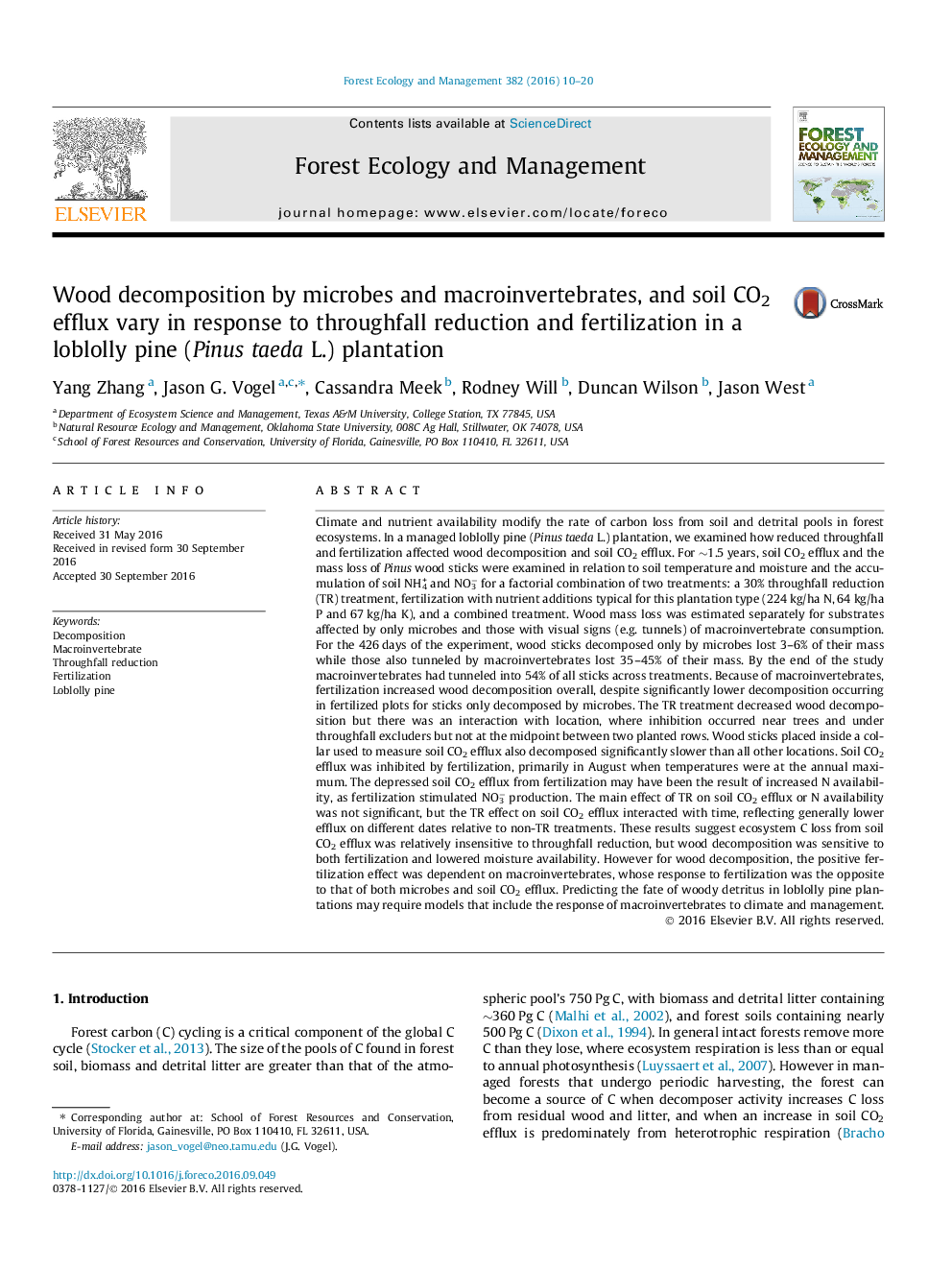| کد مقاله | کد نشریه | سال انتشار | مقاله انگلیسی | نسخه تمام متن |
|---|---|---|---|---|
| 4759689 | 1421376 | 2016 | 11 صفحه PDF | دانلود رایگان |
عنوان انگلیسی مقاله ISI
Wood decomposition by microbes and macroinvertebrates, and soil CO2 efflux vary in response to throughfall reduction and fertilization in a loblolly pine (Pinus taeda L.) plantation
دانلود مقاله + سفارش ترجمه
دانلود مقاله ISI انگلیسی
رایگان برای ایرانیان
کلمات کلیدی
موضوعات مرتبط
علوم زیستی و بیوفناوری
علوم کشاورزی و بیولوژیک
بوم شناسی، تکامل، رفتار و سامانه شناسی
پیش نمایش صفحه اول مقاله

چکیده انگلیسی
Climate and nutrient availability modify the rate of carbon loss from soil and detrital pools in forest ecosystems. In a managed loblolly pine (Pinus taeda L.) plantation, we examined how reduced throughfall and fertilization affected wood decomposition and soil CO2 efflux. For â¼1.5Â years, soil CO2 efflux and the mass loss of Pinus wood sticks were examined in relation to soil temperature and moisture and the accumulation of soil NH4+ and NO3â for a factorial combination of two treatments: a 30% throughfall reduction (TR) treatment, fertilization with nutrient additions typical for this plantation type (224Â kg/ha N, 64Â kg/ha P and 67Â kg/ha K), and a combined treatment. Wood mass loss was estimated separately for substrates affected by only microbes and those with visual signs (e.g. tunnels) of macroinvertebrate consumption. For the 426Â days of the experiment, wood sticks decomposed only by microbes lost 3-6% of their mass while those also tunneled by macroinvertebrates lost 35-45% of their mass. By the end of the study macroinvertebrates had tunneled into 54% of all sticks across treatments. Because of macroinvertebrates, fertilization increased wood decomposition overall, despite significantly lower decomposition occurring in fertilized plots for sticks only decomposed by microbes. The TR treatment decreased wood decomposition but there was an interaction with location, where inhibition occurred near trees and under throughfall excluders but not at the midpoint between two planted rows. Wood sticks placed inside a collar used to measure soil CO2 efflux also decomposed significantly slower than all other locations. Soil CO2 efflux was inhibited by fertilization, primarily in August when temperatures were at the annual maximum. The depressed soil CO2 efflux from fertilization may have been the result of increased N availability, as fertilization stimulated NO3â production. The main effect of TR on soil CO2 efflux or N availability was not significant, but the TR effect on soil CO2 efflux interacted with time, reflecting generally lower efflux on different dates relative to non-TR treatments. These results suggest ecosystem C loss from soil CO2 efflux was relatively insensitive to throughfall reduction, but wood decomposition was sensitive to both fertilization and lowered moisture availability. However for wood decomposition, the positive fertilization effect was dependent on macroinvertebrates, whose response to fertilization was the opposite to that of both microbes and soil CO2 efflux. Predicting the fate of woody detritus in loblolly pine plantations may require models that include the response of macroinvertebrates to climate and management.
ناشر
Database: Elsevier - ScienceDirect (ساینس دایرکت)
Journal: Forest Ecology and Management - Volume 382, 15 December 2016, Pages 10-20
Journal: Forest Ecology and Management - Volume 382, 15 December 2016, Pages 10-20
نویسندگان
Yang Zhang, Jason G. Vogel, Cassandra Meek, Rodney Will, Duncan Wilson, Jason West,